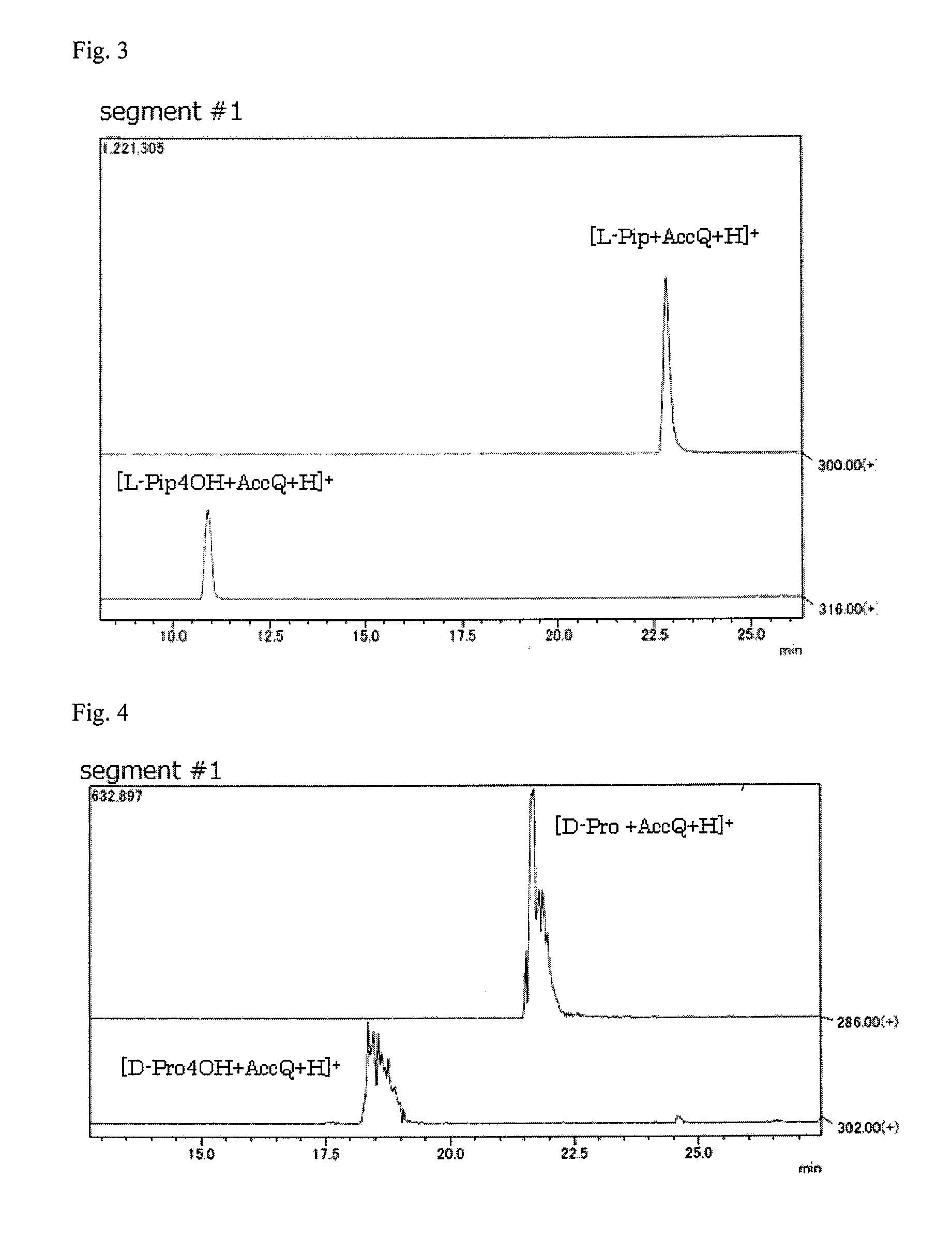Pipecolinic acid 4-hydroxylase and method for producing 4-hydroxy amino acid using same
a technology of hydroxylase and pipecolinic acid, which is applied in the field of pipe, can solve the problems of high purification load, no enzyme has so far been reported to hydroxylate 4-position of pipecolinic acid, and no function of these proteins, and achieves high optical purities and efficient production.
- Summary
- Abstract
- Description
- Claims
- Application Information
AI Technical Summary
Benefits of technology
Problems solved by technology
Method used
Image
Examples
example 1
Construction of Plasmid Expressing Pipecolic Acid 4-Hydroxylase Gene
[0092]Based on a gene sequence encoding a hypothetical protein FOXB_08233 derived from Fusarium oxysporum Fo5176, primers BOF1 and BOR1 for amplification of full-length homologous genes for the hypothetical protein FOXB_08233 were designed and synthesized. The nucleotide sequences of the primers are shown in SEQ ID NOs:13 and 14.
[0093]Fusarium oxysporum c8D was cultured overnight in a potato dextrose liquid medium (manufactured by Becton, Dickinson and Company, Japan). From the microbial cells obtained, chromosomal DNA was prepared using a DNeasy Blood & Tissue Kit (manufactured by QIAGEN).
[0094]Using the thus prepared chromosomal DNA derived from each microbial strain as a template, and the oligonucleotides of SEQ ID NOs:13 and 14 as primers, polymerase chain reaction (PCR) was carried out to amplify a DNA fragment of about 1 kbp. The PCR was carried out using Tks Gflex DNA polymerase (manufactured ...
example 2
Evaluation of Pipecolic Acid 4-Hydroxylase Activity
[0096]The six kinds of plasmids obtained in Example 1, pFoPA4H, pAoPA4H, pPcPA4H, GzPA4H, pCgPA4H, and pEnPA4H, were used for transformation of E. coli (Escherichia coli) Rosetta 2 (DE3) (manufactured by Merck Millipore Corporation) according to an ordinary method. Each recombinant E. coli obtained was cultured with shaking at 30° C. using liquid LB medium supplemented with 50 mg / L kanamycin, 15 mg / L chloramphenicol, and 1 mmol / L IPTG (isopropyl β-D-1-thiogalactopyranoside) for 20 hours, and the cultured bacterial cells were collected.
[0097]The bacterial cells obtained were subjected to reaction at 20° C. at pH 6 for 21 hours in 50 mmol / L MES (2-morpholinoethanesulfonic acid) buffer supplemented with 15 mmol / L 2-oxoglutaric acid, 5 mmol / L ascorbic acid, 5 mmol / L tris(2-carboxyethyl)phosphine hydrochloride, 0.5 mmol / L FeSO4.7H2O, 3 mmol / L citric acid, and 10 mmol / L each substrate compound.
[0098]The reaction liquids after the reaction...
example 3
Identification of Reaction Products
[0099]Each reaction liquid obtained in Example 2 was derivatized using the Waters AccQ.Tag method, and subjected to separation analysis using a high-performance liquid chromatograph-mass spectrometer (LC-MS) under the following conditions to measure amino acid reaction products.
Column: XBridge C18 5 μm (2.1×150 mm, manufactured by Waters Corporation)
Eluent A: ammonium acetate (10 mmol / L, pH 5)
Eluent B: methanol (0 to 0.5 min. (0%→1%), 0.5 to 18 min. (1%→5%), 18 to 19 min. (5%→9%), 19 to 29.5 min. (9%→17%), 29.5 to 40 min. (17%→60%), 40 to 43 min. (60%))
Flow rate: 0.3 ml / min.
Temperature: 30° C.
[0100]Detection: mass spectrometer
[0101]For the reaction liquids obtained using the six kinds of E. coli, substrate amino acids for which appearance of a new peak was found in the LC-MS analysis are shown in Table 1. Since the molecular weights of these new reaction products were found to be higher by 16 compared to the molecular weights of their substrates, i...
PUM
| Property | Measurement | Unit |
|---|---|---|
| Fraction | aaaaa | aaaaa |
Abstract
Description
Claims
Application Information
 Login to View More
Login to View More - R&D
- Intellectual Property
- Life Sciences
- Materials
- Tech Scout
- Unparalleled Data Quality
- Higher Quality Content
- 60% Fewer Hallucinations
Browse by: Latest US Patents, China's latest patents, Technical Efficacy Thesaurus, Application Domain, Technology Topic, Popular Technical Reports.
© 2025 PatSnap. All rights reserved.Legal|Privacy policy|Modern Slavery Act Transparency Statement|Sitemap|About US| Contact US: help@patsnap.com



